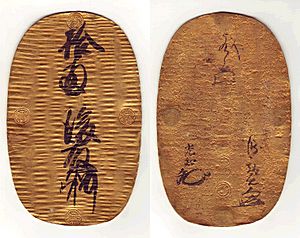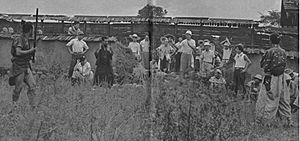Tenshō (Momoyama period) facts for kids
Tenshō (天正) was a special name for a time period in Japanese history. It's like how we have years, but in Japan, they also used era names. The Tenshō period came after an era called Genki and before Bunroku.
This important time started in July 1573 and ended in December 1592. During these years, two emperors ruled Japan: Emperor Ōgimachi and Emperor Go-Yōzei.
The name Tenshō means "Heavenly Virtue." It was a time of big changes and important events in Japan.
Key Events of the Tenshō Era
In 1573, a powerful leader named Oda Nobunaga suggested that a new era should begin. He chose the name Tenshō, which meant "heavenly righteousness."
Here are some of the main things that happened during this time:
- 1573 (Tenshō 1): The shogun, Ashikaga Yoshiaki, who was a military leader, decided to become a Buddhist priest. This meant he stepped away from his powerful role.
- 1576 (Tenshō 3): A famous battle called the Battle of Nagashino took place. Also, Takeda Katuyori ordered the rebuilding of the Asama Shrine near Mount Fuji.
- 1582 (Tenshō 10): Oda Nobunaga ordered the destruction of some buildings that Takeda had built at the Asama Shrine. Another battle, the Battle of Temmokuzan, happened this year.
- 1582 (Tenshō 10): A group of four Japanese boys, who were Catholic, traveled all the way to Rome to meet Pope Gregory XIII. This trip is known as the "Tenshō Embassy" or the "Boys' Mission." It was a big deal for Japan to send young people so far away!
- 1583 (Tenshō 11): The Battle of Shizugatake occurred.
- 1584 (Tenshō 12): The Battle of Komaki and Nagakute took place. Later that year, another strong leader, Toyotomi Hideyoshi, was given the important title of kampaku (chief advisor) by Emperor Ōgimachi.
- 1586 (Tenshō 14): Emperor Ōgimachi stepped down from his role. His grandson, Emperor Go-Yōzei, became the new emperor. Also, Toyotomi Hideyoshi arranged for his youngest sister to marry Tokugawa Ieyasu, another powerful figure. Hideyoshi himself was given an even higher title, Daijō-daijin (Grand Minister).
- 1587 (Tenshō 15): Special gold and silver coins were made. They were called Tenshō-tsūhō. The gold coins, known as Tenshō-ōban, were shaped like ovals.
Between 1589 and 1590, a group of diplomats from Korea, led by Hwang Yun-gil, visited Japan. They met with Toyotomi Hideyoshi.
Tenshō in Movies
The famous Japanese film The Seven Samurai, directed by Akira Kurosawa, tells a fictional story that takes place during the 15th year of the Tenshō era.
Related pages
- Tenshō (Heian period)
- National Diet Library, "The Japanese Calendar" -- historical overview plus illustrative images from library's collection



